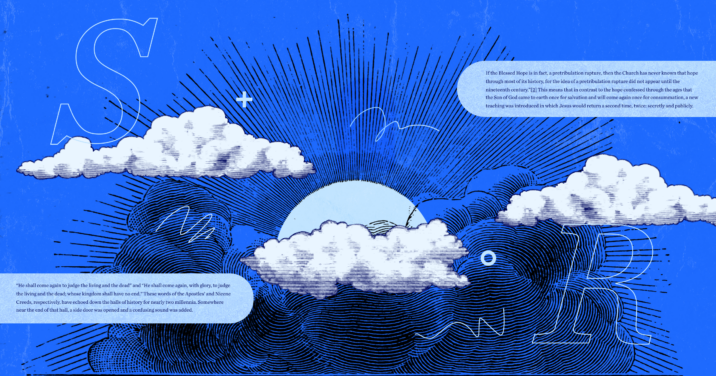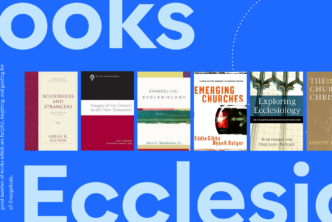“He shall come again to judge the living and the dead.”
—Apostles’ Creed
“He shall come again, with glory, to judge the living and the dead; whose kingdom shall have no end.”
—Nicene Creed
These words have echoed down the halls of history for nearly two millennia. Somewhere near the end of that hall, a side door was opened and a confusing sound was added.1 That sound was the teaching of a secret “rapture” of the church from this world before the Second Coming. George Eldon Ladd expressed the novelty of this view in the history of the church in these words:
The hope of the Church throughout the early centuries was the second coming of Christ, not a pretribulation rapture. If the Blessed Hope is in fact, a pretribulation rapture, then the Church has never known that hope through most of its history, for the idea of a pretribulation rapture did not appear until the nineteenth century.2
This means that in contrast to the hope confessed through the ages that the Son of God came to earth once for salvation and will come again once for consummation, a new teaching was introduced: Jesus would return a second time, twice: secretly and publicly.
The new leader of the Calvary Chapel movement, Brian Broderson, calls the rapture “part one of the second coming” and tries to make the case for this by saying the first coming actually had two parts as well.3 He defines the rapture as the time when “every believer in the Lord Jesus Christ is miraculously and instantly taken to heaven without experiencing death.”4 Modern American evangelicals love their secret rapture. As of this writing, over 35 million copies of Hal Lindsey’s The Late Great Planet Earth (1970) and 63 million copies of The Left Behind (1995–2007) series have been sold.
I agree there will be a rapture. The issue is that it’s distinguished from the Second Coming. I believe the truth of the Bible is that the rapture is the Second Coming. I will leave the intricate details of historical and systematic theology to others,5 but here I will give a simple and practical explanation why I believe the truth is that the rapture is the Second Coming, focusing on one of the main “rapture texts,” 1 Thessalonians 4:13–18.
But we do not want you to be uninformed, brothers, about those who are asleep, that you may not grieve as others do who have no hope. For since we believe that Jesus died and rose again, even so, through Jesus, God will bring with him those who have fallen asleep. For this we declare to you by a word from the Lord, that we who are alive, who are left until the coming of the Lord, will not precede those who have fallen asleep. For the Lord himself will descend from heaven with a cry of command, with the voice of an archangel, and with the sound of the trumpet of God. And the dead in Christ will rise first. Then we who are alive, who are left, will be caught up together with them in the clouds to meet the Lord in the air, and so we will always be with the Lord. Therefore encourage one another with these words. (1 Thess 4:13–18 ESV)6
Why focus on this text? John Walvoord said, “1 Thessalonians … contributes more to the doctrine of the Rapture than any other book of the New Testament.” After surveying several passages in 1 Thessalonians he believed taught the rapture, he said, “These passages, of course, are confirmed and explained in greater detail in the major section on the Rapture in 1 Thessalonians 4:13–18 and 5:1–11.”7
Exploring 1 Thessalonians 4:13–18
Paul’s reason for writing (v. 13)
In verse 13, Paul gives his reason for writing his letter as he deals with the pastoral reality of death. “Asleep” is an Old Testament euphemism for death. Those who died trusting in the Lord were “sleeping with their fathers” (Deut 31:16; 2 Sam 7:12; 1 Kgs 2:10). Paul gives his purpose for addressing this topic: “that you may not grieve as others do who have no hope.” Christians should not grieve over the loss of believing loved ones like the world grieves over its dead. Just think of a heart-wrenching funeral of an unbeliever and the hopeless grief of those left behind.
Our eschatology (theology of the last things or “end times”) is meant to comfort us. Theology matters. As the passage unfolds, he deals with this pastoral reality we all face in light of what Jesus has already done and what he will do when he returns. These Christians were worried. Their believing friends and family had died before Jesus returned. Had they missed out on the glories of heaven? In 2 Thessalonians 2:1–2, Paul said he did not want them “to be quickly shaken in mind or alarmed either by a spirit or a spoken word, or a letter seeming to be from us, to the effect that the day of the Lord has come.” He told Timothy to “avoid irreverent babble” that “lead[s] people into more and more ungodliness” and “spread[s] like gangrene.” Then he named names: “Hymenaeus and Philetus, who have swerved from the truth, saying that the resurrection has already happened” (2 Tim. 2:15–18). Had Jesus already returned? Had the dead in Christ already been raised? Paul addressed these misunderstandings and anxieties.
A summary statement (v. 14)
Paul goes on to summarize why the Thessalonians should not be uninformed and grief-stricken.
1. A pattern for us
Paul sets up a pattern: “Jesus died and rose again” is parallel with “those who have fallen asleep” (“Jesus died”) and those whom “God will bring with [Jesus].” Jesus died, and there are believers who have died; Jesus rose again, and believers, too, will be raised. I cannot stress how important this pattern is. Broderson, for example, simply dismissed the interpretation that this whole section is dealing with the resurrection.8 But that’s the pattern Paul sets up! Death, then resurrection.
2. A truth for us
Paul says something about the dead in Christ between death and the final resurrection or the “intermediate state.”9 “Through Jesus,” who is returning again to earth, “God will bring with him those who have fallen asleep.” How can Jesus bring them with him if they’re in the ground? The answer is that there’s more to us than our bodies. At death, our souls go to be with Jesus in God’s presence. The Heidelberg Catechism (1563) confesses this when it says “my soul will be taken immediately after this life to Christ its head” (Q&A 57). When Jesus returns, he will bring “with him” from heaven the souls of those who have died in faith to be reunited with their bodies that will be raised. Philippians 1 teaches this as well. Paul’s prayer is that “Christ will be honored in my body, whether by life or by death” (v. 20). Then he says of his life or death, “For to me to live is Christ, and to die is gain” (v. 21). What’s the “gain” of life? “Fruitful labor for me” (v. 22). What’s the “gain” of death? “To depart and be with Christ, for that is far better” (v. 23). Note Paul’s agony between the two: “I am hard pressed between the two” (vv. 22–23).
Paul’s summary is that Jesus died and rose again and so too all those who die believing in him are with him now in soul and will rise in their bodies.
Explanation (vv. 15–17)
Paul gives a fuller explanation: “For this we declare to you by a word from the Lord” (v. 15). Here’s the teaching from the Lord: “we who are alive, who are left until the coming of the Lord, will not precede those who have fallen asleep” (v. 15). In other words, there’s no need to grieve like the world does for their dead: we won’t go to be with the Lord until they are resurrected first.
Parousia
Pay careful attention to the word Paul uses in verse 15 for the “coming” of Jesus. Parousia was used in ancient religious literature to describe the manifestation of a hidden god. It was used in civil literature to describe an official visit of a high-ranking person—a king or emperor—while the leading citizens would go out to meet and escort him the rest of the way.10 In the New Testament, every time Jesus, Paul, James, Peter, and John use parousia of Jesus (with only one exception), they speak of the once-for-all Second Coming. The exception is 2 Peter 1:16, where Peter uses parousia to describe “the power and coming of our Lord Jesus Christ” in reference to his Transfiguration (Matt 17). The word is never used of a secret rapture.
Jesus’s use of parousia
In Matthew 24, Jesus said the temple was going to be destroyed (which the Roman General Titus accomplished AD 70). His disciples then asked him two questions:
- “When will these things be,” meaning, the temple’s destruction, and,
- “What will be the sign of your coming?” (v. 3).
In contrast to the many false prophets who would speak of the Lord’s coming, Jesus said don’t listen to them because you will know when he comes: “For as the lightning comes from the east and shines as far as the west, so will be the coming of the Son of Man” (v. 27). The parousia is as visible and dramatic as lightning. He went on to make a comparison: “For as were the days of Noah, so will be the coming of the Son of Man” (v. 37). How so? “For as in those days before the flood they were eating and drinking, marrying and giving in marriage, until the day when Noah entered the ark, and they were unaware until the flood came and swept them all away, so will be the coming of the Son of Man” (vv. 38–39). Many of our friends who affirm the secret rapture like to point to the verses that follow, in which Jesus says two men will be working in a field and two women will be working at a mill but one will be taken and one left. They say those “taken” are caught up in the rapture. There’s a problem with this: Jesus just said those “swept away” in Noah’s day were the enemies of God; those “taken” are not raptured, but taken for judgment!
The apostles’ use of parousia
The apostles used parousia the same way to speak of the once-for-all, public, Second Coming of Christ.
Paul says Jesus was raised from the dead as the firstfruits of the final resurrection. This means more than Jesus being temporally the first one raised. He’s representationally the firstfruits, meaning that because he was made alive in his resurrection therefore “at his coming those who belong to Christ” will also be made alive (1 Cor 15:23). It’s one resurrection, but two phases.11 Paul calls the Thessalonians his joy and crown “before our Lord Jesus at his coming” (1 Thess 2:19). He prayed that God would “establish your hearts blameless in holiness before our God and Father at the coming of our Lord Jesus with all his saints” (1 Thess 3:13) and again that they would “be kept blameless at the coming of our Lord Jesus Christ” (1 Thess 5:23). Even more telling is 2 Thessalonians 2, where Paul speaks of “the coming of our Lord Jesus Christ and our being gathered to him” (v. 1). Some might say this is the rapture. But just a few verses later, he speaks of the revelation of the Antichrist “whom the Lord Jesus will kill with the breath of his mouth and bring to nothing by the appearance of his coming” (v. 8). Do you see that? Paul uses the same word in verse 1 as he does in verse 8 to describe Jesus’s “coming,” which is the same word used in 1 Thessalonians 4:15. Even more, when Paul speaks of “being gathered” (2 Thess 2:1), he uses the same word Jesus used in Matthew 24:31: “[God] will send out his angels with a loud trumpet call, and they will gather his elect from the four winds, from one end of heaven to the other.” The angels’ trumpet, the coming of the Lord, and our being gathered to Jesus: these are all the same event.
James tells his readers, “Be patient … until the coming of the Lord … for the coming of the Lord is at hand” (5:7, 8).
Peter says the world mocks, asking, “Where is the promise of his coming?” (2 Pet 3:4). He goes on to speak of God’s patience with an ungodly world: “with the Lord one day is as a thousand years, and a thousand years as one day” (v. 8). “The day of the Lord”—not the secret rapture—“will come like a thief” and on that day “the heavens will pass away” (v. 10). Therefore we are to be holy, “waiting for and hastening the coming of the day of God” when he begins “a new heavens and a new earth wherein righteousness dwells” (vv. 11–13).
Finally, John tells believers “abide in [Jesus], so that when he appears we may have confidence and not shrink from him in shame at his coming (1 John 2:28).
A summary of the New Testament’s use of parousia
To summarize, Jesus’s parousia will be as dramatic and visible as lightning (Matt 24:27; 1 Thess 4:16). At his parousia, the blessed will be resurrected just like Jesus the firstfruits (1 Cor 15:23) and be “gathered to him” (2 Thess 2:1; Matt 24:31), while the Antichrist will be destroyed (2 Thess 2:8) and the wicked will be “swept away” like in “the days of Noah” (Matt 24:37–39). Then the present heavens will pass away in the fire of judgment and a new heavens and a new earth will emerge (2 Pet 3:10, 12–13). Until then, while God is establishing our hearts and keeping us blameless in holiness (1 Thess 3:13; 5:23), we are to be patient, holy, and godly, abiding in Christ (Jas 5:7, 8; Pet 3:11; 1 John 2:28) so that we will be confident and not ashamed at his coming. Surveying these texts, Ladd said: “The parousia of Christ is His second coming, and it will bring both salvation and judgment: salvation of the saints, and judgment of the world.”12
Run a Bible Word Study on parousia in the Logos Bible Study app. Get it free, if you don’t already have it.
The sequence of events at the parousia
All this brings us back to Paul’s explanation in 1 Thessalonians 4:15: “we who are alive, who are left until the [second] coming of the Lord, will not precede those who have fallen asleep” (v. 15; emphasis added). How? Look at the sequence of events.
First, “the Lord himself will descend from heaven” (v. 16). He could easily have said, “The Lord is coming back.” Instead, Paul heaps up a series of three descriptions of this “coming” or “descen[t]” to captivate our imaginations. The Lord descends with “a cry of command” (v. 16). This term was used of a boat master crying out to his rowers to row in unison; of a horseman crying out to his horse to speed up or slow down; of a hunter crying out to his hounds; and of an officer crying out commands to his soldiers. It is the word of an authority to his subjects.13
The Lord will come climactically with this authority, and everyone will listen. The Lord will descend with “the voice of an archangel” (v. 16). Angels proclaimed the Lord’s coming to destroy Sodom and Gomorrah (Gen 18:1–21) and angels proclaimed our Lord’s first coming (Luke 1:26–38; 2:8–14). When the Lord comes a final time, it will not just be at an angel’s heralding, but with the heralding call of the chief of angels, the archangel.
The Lord descends with “the sound of the trumpet of God” (v. 16). The Old Testament speaks of two trumpets: the silver trumpet or the shofar (or ram’s horn). The silver trumpet was used in worship, but the shofar was used in war. The best example was Jericho (Josh 6). When Jesus comes it will be as the Captain of the Lord’s armies with a war cry to gather his troops to execute vengeance upon his enemies. This is “the last trumpet” (1 Cor 15:52).
After “the Lord himself … descend[s],” the second event is this: “the dead in Christ will rise first” (v. 16). In order for the secret rapture to work in this context, Mark Hitchcock says “the rapture applies to believers in the church age because Paul calls them ‘the dead in Christ.’ Old Testament saints are not in Christ through the baptizing work of the Holy Spirit.”14 He adds an impassable chasm between Old and New Testament believers to fit this theory. Where does Paul say this? Even the 1917 Scofield Reference Bible, which popularized the doctrine of the rapture, said “caught up” referred to the resurrection of all believers: “Not church saints only, but all bodies of the saved, of whatever dispensation, are included in the first resurrection.” On 1 Corinthians 15:52, Scofield said, “The ‘first resurrection,’ that ‘unto life,’ will occur at the second coming of Christ, 1 Corinthians 15:23, the saints of the O.T. and church ages meeting Him in the air, 1 Thessalonians 4:16; 1 Thessalonians 4:17.”15 There are not two comings and two resurrections.
After “the Lord … descend[s]” and “the dead in Christ” are raised, “then” the third event occurs: “We who are alive, who are left, will be caught up together with them [those just resurrected] in the clouds to meet the Lord in the air” (v. 17). Hitchcock resorts to humor to try and make it sound ridiculous that at the Second Coming the resurrected and translated saints meet Jesus then return with him: “I call this, the ‘Yo-Yo’ view of the rapture. We are going to be caught up to Christ, meet Him in the air, and then do a quick U-turn and come right back down to the earth with Him.”16 But this is what Paul says! When Paul says “in the clouds” we will “meet the Lord in the air,” this is not just a spatial remark. This is Old Testament imagery. The clouds were a visible demonstration of the presence of the Lord. Moses met the Lord in the cloud (Exod 19; 24). Isaiah met with him in the cloud of his glory in the temple (Isa 6). When our Lord appears, we will all meet with him in his glorious appearance. In contrast to the Israelites, who were “afraid and trembled,” “stood far off,” and even told Moses to “speak to us … do not let God speak to us, lest we die” (Exod 20:18–19), we will meet with him face to face, in joy and wonder.
The hope the inspired apostle Paul offers us in 1 Thessalonians 4 is not for a secret rapture. There was nothing secret about the Lord’s coming upon Sodom and Gomorrah in judgment, about the walls falling down in Jericho, about the birth of the Son of God upon earth, or about what is going to happen when the Lord returns. The hope of the rapture is for a climactic, dramatic, public, universal, and visible Second Coming.17 We need to put our hope in the right event. Our “blessed hope,” is “the appearing of the glory of our great God and Savior Jesus Christ” (Titus 2:13). That’s our hope. “And so we will always be with the Lord” (v. 17).
Conclusion (v. 18)
Paul concludes this section of his letter with a word to those who are ignorant of the state of their lost loved ones who trusted in Christ. He desires to equip believers to minister one to another: “encourage one another with these words” (v. 18). The doctrine that the rapture is the Second Coming of our Lord should cause us to be at peace with God, not be terrified whether we will be taken or not. It should bring us eternal comfort, not feelings of condemnation.
Applying Paul’s teaching in 1 Thessalonians 4
As we consider how Paul applies theology to the anxiety of the Thessalonians, let me conclude with several ways Jesus’s return is practical for us.
It gives hope in grief
When I know that Jesus is coming a second time for me, this transforms my grief. Paul does not say that we will not grieve; we certainly will. Those of us who have lost loved ones do not need to be ashamed for our grief. It’s part of being human, but it’s transformed for believers. What Paul actually says here is that we must not grieve “as others do who have no hope.” What is it like to grieve as those whom Paul describes elsewhere as “having no hope and without God in the world” (Eph 2:12), since they have no hope of heaven? Grieving is feeling sorry that a loved one’s life was cut short. Grieving is feeling sorry for those left behind. Grieving is feeling sorry for oneself. We grieve, but in a Christian way, in a Christ-centered way, in a hopeful way.
It gives hope after death
Our grief is transformed by the knowledge of the coming of the Lord, as we have sure hope for what happens after death. Christ’s coming gives hope after death. These Christians were grieving because they were uninformed, unsure about what happened to their believing loved ones who died before the coming of the Lord. Paul describes our hope for what happens after death as “falling asleep.” He goes on to say that God will bring with him those who have fallen asleep (v. 14). Does this mean that when we die, our souls go to sleep in an unconscious state until the coming of the Lord? No.
First, it means that the body is dead. We speak to our children in this way when someone they love has died. What did they look like? It looked like they were sleeping. To say they have fallen asleep is an observation of what the body looks like it is doing. But what about the soul?
Second, it means that the soul is at rest. To sleep is to rest from the toils of our day-to-day lives and escape the cares of this world. When we die, we rest because we are asleep in Jesus. Look at how the book of Revelation says this: “Blessed are the dead who die in the Lord from now on.” ‘Blessed indeed,’ says the Spirit, ‘that they may rest from their labors, for their deeds follow them!’” (Rev 14:13; cf. Rev 6:9–11).
John Calvin described the hope the Christian has in death like this: “To sleep in Jesus means to retain in death the union which we have with Christ, for those who are ingrafted into Christ by faith share death in common with Him, in order that they may share with Him in life.”18 Because our loved ones placed their hope in the Lord, we have hope concerning them. In the beautiful words of the 1662 Book of Common Prayer in its committal of a body at the graveside:
Forasmuch as it hath pleased Almighty God of his great mercy to take unto himself the soul of our dear brotherhere departed, we therefore commit his body to the ground; earth to earth, ashes to ashes, dust to dust; in sure and certain hope of the Resurrection to eternal life, through our Lord Jesus Christ; who shall change our vile body, that it may be like unto his glorious body; according to the mighty working, whereby he is able to subdue all things to himself.
It gives hope for eternity
The coming of Christ gives hope for eternity. We grieve in hope when fellow believers die because after death their souls are with the Lord. When he returns, all his people will remain with him for eternity. As Paul says at the end of verse 17, “And so we will always be with the Lord.” Always. What a promise! We will be in our Lord’s eternal presence forever. The psalms say “in your presence there is fullness of joy; at your right hand are pleasures forevermore” (Ps 16:11) and “I shall behold your face in righteousness; when I awake, I shall be satisfied with your likeness” (Ps 17:15).
It gives hope for reunion
This doctrine also gives us hope for reunion with our loved ones who have died in faith: “we … will be caught up together with them … to meet the Lord” (v. 17). The Second Coming will bring with it a heavenly reunion between us and the Lord and between us and our loved ones who have died in Christ. This will be a conscious and personal reunion. Paul switches from “those” asleep and “the dead” in Christ to the personal “with them.” Paul assumes the Thessalonians know of whom he is speaking. The Scottish preacher James Fergusson once that this was “a choice cordial [an invigorating liqueur] for comfort against all excessive sorrow.”19
J. C. Ryle said this
lights up the valley of the shadow of death. It strips the sickbed and the grave of half their terrors … .We parted in sorrow, and we shall meet in joy; we parted in stormy weather, and we shall meet in a calm harbour; we parted amidst pains and aches, and groans, and infirmities: we shall meet with glorious bodies, able to serve our Lord for ever without distraction.20
Will you join me in joining that historical echo? “He shall come again to judge the living and the dead”; “He shall come again, with glory, to judge the living and the dead; whose kingdom shall have no end.” This coming of Jesus is the rapture. Don’t be uninformed. Encourage one another.
Resources mentioned in this article
The Blessed Hope: A Biblical Study of the Second Advent and the Rapture
Regular price: $13.99
A Case for Amillennialism, Expanded Edition: Understanding the End Times
Regular price: $21.99
A Greek–English Lexicon of the New Testament and Other Early Christian Literature, 3rd ed. (BDAG)
Regular price: $164.99
Related articles
- What Is Eschatology? 4 Views, Why There’s Disagreement & More
- Can We Trust the Bible? The Resurrection Says Yes
- Logos Tech Tip: Study the Resurrection with the Factbook
- On the history of the ancient church’s hope and shift in the modern period, see George Eldon Ladd, “The Historic Hope of the Church” and “The Rise of and Spread of Pretribulationism,” in The Blessed Hope: A Study of the Second Advent and the Rapture (Grand Rapids, MI: Eerdmans, 1975), 19–60. Originally published in 1956.
- Ladd, Blessed Hope, 19.
- Brian Broderson, Caught Up! What the Bible Says About the Rapture of the Church (Lansing, MI: Calvary, 2010), 7–8.
- Broderson, Caught Up!, 6. Calvary Chapel’s “Statement of Faith” also says, “We believe the church will be delivered from the ‘hour of trial’ which will come upon all who dwell on the earth, being ‘caught up’ in the clouds to meet the Lord in the air (the Rapture) (1 Thessalonians 4:16–17, 1 Corinthians 15:51–55, Revelation 3:10).”
- See Anthony A. Hoekema, The Bible and Future (Grand Rapids, MI: Eerdmans, 1979); Ladd, Blessed Hope; Kim Riddlebarger, A Case for Amillennialism: Understanding the End Times (Grand Rapids,: Baker Books, 2003); Cornelis P. Venema, The Promise of the Future (Edinburgh: The Banner of Truth Trust, 2000). For audio resources, see Kim Riddlebarger’s blog, “The Riddleblog,” for an extensive audio library.
- For my full exposition of 1–2 Thessalonians, see my From the Pen of Pastor Paul: 1–2 Thessalonians (UK: EP Books, 2015).
- John F. Walvoord, The Rapture Question (Grand Rapids, MI: Zondervan, 1979), 197, 200. Originally published in 1957.
- Broderson, Caught Up!, 10–11.
- On the intermediate estate, listen to Cornelis Venema’s four-part series, “What Happens After I Die?”
- On the use of parousia in ancient literature and the New Testament, see Walter Bauer, A Greek-English Lexicon of the New Testament and Other Early Christian Literature (Chicago: University of Chicago Press, 1979), 630; F. F. Bruce, 1 & 2 Thessalonians, Word Biblical Commentary 45 (Waco, TX: Word Books, 1982), 56–57.
- On this passage, see Richard B. Gaffin Jr., Resurrection and Redemption: A Study in Paul’s Soteriology, Biblical & Theological Studies, 2nd ed. (Phillipsburg, NJ: P&R, 1987), 34–36.
- Ladd, Blessed Hope, 65.
- On this “cry of command” (keleusmati), see Bruce, 1 & 2 Thessalonians, 100.
- Mark Hitchcock, The Truth and Timing of the Rapture (Dallas, TX: Dallas Theological Seminary, 2014), 4.
- Contra Broderson and Hitchcock, we see this clear reference to the final resurrection as the rapture. Broderson, Caught Up!, 9, 29–30; Hitchcock, Truth and Timing of the Rapture, 4, 10. See also Hal Lindsey, The Late Great Planet Earth (Grand Rapids, MI: Zondervan, 1970), 138–41.
- Hitchcock, Truth and Timing of the Rapture, 5.
- As Ladd said on 1 Thessalonians 4:13–18, “It is very difficult to find a secret coming of Christ in these verses.” Ladd, Blessed Hope, 63.
- John Calvin, The Epistles of Paul the Apostle to the Romans and to the Thessalonians, trans. Ross Mackenzie, Calvin’s Commentaries 8 (Grand Rapids, MI: Eerdmans, 1961), 363.
- James Fergusson and David Dickson, Galatians, Ephesians, Philippians, Colossians, Thessalonians & Hebrews, Geneva Series Commentary (1841, reprinted; Edinburgh: Banner of Truth, 1978), 430 col. 1.
- J. C. Ryle, Shall We Know One Another, and Other Papers (New York: Cassell, Petter, and Galpin, 1871), 16–18.






